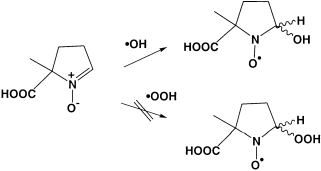5-Carboxy-5-methyl-1-pyrroline N-oxide: a spin trap for the hydroxyl radical
Abstract
The in vivo in situ detection of hydroxyl radical (HO˙) in real time has been one of the great challenges of free radicals in biology. While we have been able to identify this free radical as a secondary biomarker of HO˙, the discovery that 5-carboxy-5-methyl-1-pyrroline N-oxide 2 can specifically spin trap HO˙ at the expense of superoxide (O2˙−) opens new avenues of research. In particular, nitrone 2 will allow us to detect HO˙ from low doses of radiation in animal tumors in real time.


 Please wait while we load your content...
Please wait while we load your content...